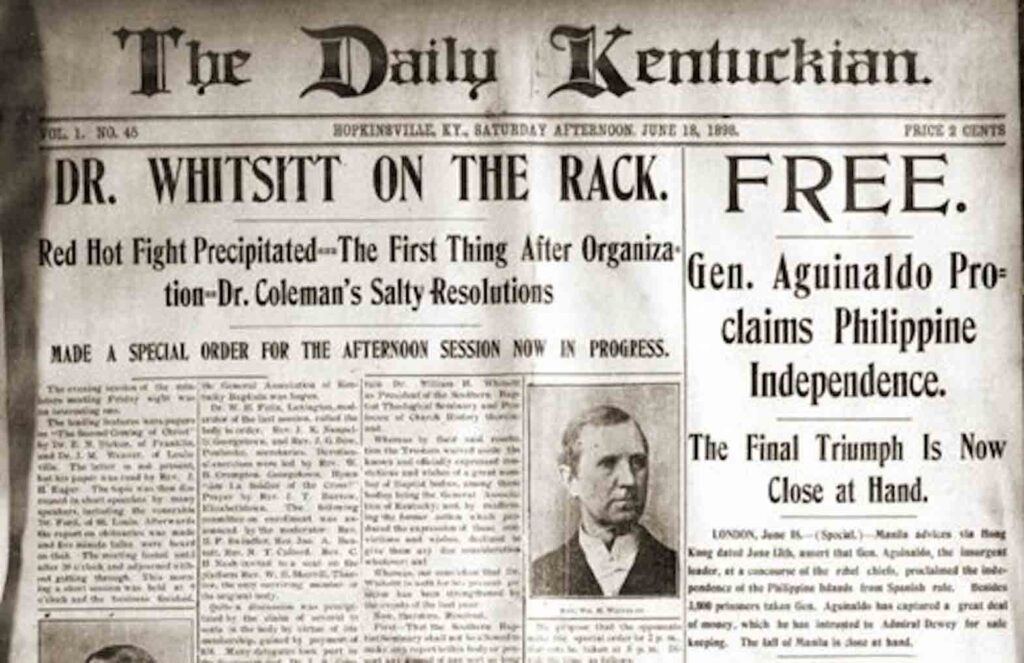June 1898 — Emilio Aguinaldo takes the lead in PH

Emilio Aguinaldo declared Philippine Independence from the diminished Spanish Empire on June 12, 1898, at Kawit, Cavite.
In June 1898, Admiral Dewey and President Aguinaldo still needed each other against the beleaguered Spanish colonial forces.
In June 1898, the Spanish-American War in the Philippines presented many challenges to the Spanish, Americans and Filipinos. The Spanish forces throughout Luzon were collapsing and retreating to their entrenchments surrounding Manila. The Americans in Manila Bay, many miles from the United States, were impatiently and anxiously waiting for ground force reinforcements. The Filipinos, under Emilio Aguinaldo’s leadership, had the Spanish troops on the run and were developing the foundation for an independent republic.
The Spanish soon realized that the Filipino fighters of June 1898 were not the same Filipinos rebels of 1896. The intervention by the United States changed the military situation dramatically. The Filipino troops were capturing Spanish garrisons throughout Luzon. Aguinaldo’s men had captured about 7,000 Spanish soldiers from some of the smaller garrisons in Luzon. The garrisons that refused to capitulate to the Filipinos were isolated and cut off.
The Spanish forces lacked the skills of repositioning and moving men where they were needed. They simply were not a mobile fighting army. The Spanish liked fixed fortifications and entrenchments. Shortly, most of the remaining Spanish soldiers were positioned in earthworks and entrenchments surrounding Manila.
Aguinaldo decided to use the same tactic on the Spanish. He ordered the construction of breastworks around Manila directly facing the Spanish. He also cut off the water supply and food deliveries to the city. The blockade caused suffering and privations for the Spanish military and the civilian residents of Manila. Aguinaldo offered terms of surrender to the Spanish leadership, but the latter, with pride and arrogance, would never give up without a fight.
You may also like:
Start of Spanish-American War on April 20, 1898 boded ill for PH
1898, the year of dramatic changes for Spain, PH and the US
The Americans were certainly in better shape than the Spanish, but June 1898 was a long and lingering month for the Americans. The U.S. certainly controlled Manila Bay with modern naval vessels. They could fire at Spanish defensive positions in Manila with little resistance. They had some marines and navy-blue jackets at Sangley Point and Corregidor, but the United States had minimal control of the ground in Luzon. In June, the Americans were dependent on Aguinaldo’s ground forces whether they admitted it or not.
Admiral George Dewey was informed that the first troop transport had departed San Francisco on May 25, 1898. Dewey knew that the crossing of the Pacific Ocean to Manila would take almost 30 days. Essentially, the first expeditionary forces under Major General Wesley Merritt’s command would not arrive at Manila until the end of June.
The first American soldiers did reach the Philippines before the end of June. Brigadier General Thomas Anderson arrived in Manila Bay on June 30, 1898. He had 115 officers and 2,386 enlisted men under his control.
In June 1898, the Spanish forces in Manila totaled approximately 20,000. The American troop strength would not reach 10,000 until Brigadier General Arthur MacArthur reached the Philippines on July 25, 1898. The Americans were still out-manned significantly by the Spanish troops. Once again, the Americans still needed Aguinaldo’s troops to offset the superior number of Spanish soldiers.
In less than week after Emilio Aguinaldo returned to the Philippines on May 19, 1898, he had control of the Filipino revolutionary forces mainly on Luzon. He assumed the title Dictator on May 24, 1898. In quick succession during the month of June, his forces either had the Spanish retreating hastily to Manila, having their garrisons isolated, or losing thousands of Spanish soldiers as prisoners of war. In addition, Aguinaldo troops were able to break the formidable Bacoor-Zapote Line in Cavite Province.
Aguinaldo received and accepted intellectual and pragmatic advice from prominent Filipinos on what the new country should represent and offer. He declared Independence from the diminished Spanish Empire on June 12, 1898, at Kawit, Cavite. He discarded the title Dictator on June 23, 1898 and became the President of the new revolutionary government. During the month of June, the normal functions of government, such as civil administration, a cabinet, a justice system and a military draft, were established by the revolutionary government.
In the month of June, the relationship between the Americans and Filipinos was essentially cordial and cooperative. Admiral Dewey and President Aguinaldo appeared to respect and admire each other. At the same time, Admiral Dewey started receiving orders from the Navy Department in Washington D.C. not to make any formal alliances or promises to Aguinaldo. Regardless, in June 1898, Admiral Dewey and President Aguinaldo still needed each other.
Dennis Edward Flake is the author of three books on Philippine-American history. He is a public historian and former park ranger in interpretation for the National Park Service at the Eisenhower National Historic Site in Gettysburg, PA. He can be contacted at: flakedennis@gmail.com

